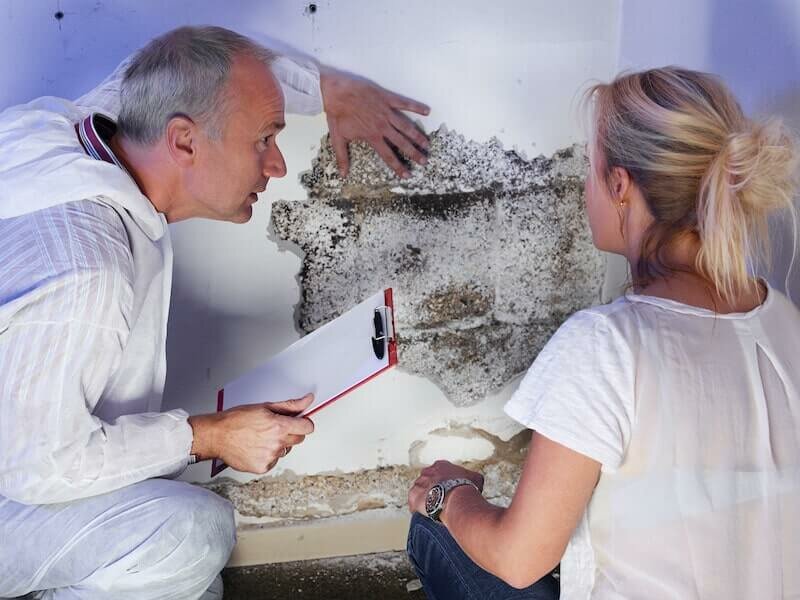Every home has a little mold. Selling a house with mold damage, however, is another story. Not only can mold damage walls and floors in your home, but it can also make you and your family as well as the buyer and their family sick. Plus, no one wants to buy a moldy house.
A competent real estate agent will tell you that mold removal is the best choice versus selling a house with mold unless you follow specific steps to protect yourself legally. Mold remediation, however, can be very costly. If you are trying to sell a house with mold, here are a few things you need to know to make the sale legal, smooth and problem-free.

Selling a House with Mold in Texas
Companies that buy houses in Texas are a dime a dozen. But the rules about selling a house with mold in Texas are often misunderstood. A more relevant question is whether your mold problem is extensive enough that disclosing it could cost you a sale?
Additionally, it is important to understand that there are rules about dealing with mold in a home and what you must do if you want to sell your house with mold in Texas. It might be tempting to offer up your house to one of those “we buy houses in Arlington” advertisements you see everywhere, but doing that without being aware of a potential mold problem can be disastrous if the buyer finds out.
First and foremost, you must come to terms with the fact that you will have to inform potential buyers, unless you do complete remediation and renovation of the affected area. Mold can grow in any home, so you need to determine if your mold has damaged the home. Next, you need to figure out what type of mold you have.
Most molds are not a health issue. Some, however, like black mold (Stachybotrys) can cause major health hazards. According to the Centers for Disease Control and Prevention, mold spores from toxic mold can destroy the air quality, cause a runny nose, watery eyes, and sneezing, affect immune systems and even cause asthma.
Additional negative health effects can happen if the mold exposure is the result of an infestation.
Legally, if the black mold is not included in disclosure forms as part of the sale agreement, it can result in a lawsuit.
Your mold issue will likely be discovered by a home inspector during the general home inspection, so it does no good to ignore it. If you discover mold damage, you may want to consider a mold inspection.
Once the mold is discovered, you have a choice:
- Fix the mold growth issue yourself with household items like bleach or vinegar
- Call in mold remediation services, which likely will also require a contractor
- Be upfront about the problem and sell the house “as is,” but with a lot of disclosure
Factoring into that are the following as you consider selling your house and having a mold issue:
- Most buyers will bolt if they know there is a mold problem
- Full disclosure is the best way to go if you do not choose to address the problem
- The advice of your realtor is probably the best advice you will get
- Not addressing the mold damage issue or even the presence of mold will lead to a lower sale price regardless of its market value and probably a cash offer
- You will likely be stuck waiting for a cash buyer as most lenders will not allow borrowing on a house with mold problems
If you are ok with all of the above, then you can sell your house as-is.
Assess the Damage of Mold to Your House
To make an informed decision regarding selling your home with mold, you must understand how large a problem you have. It is fair to assume that if you see it in your living space, mold damage exists behind your walls, likely under your floor, and is because of water damage.
Mold usually reveals itself by sight or smell. If you notice black spotting on drywall or the floor in a poorly ventilated room, it likely is the beginning of mold taking over. If you smell mold or mildew and it is particularly strong in one area of your home or another, you likely have a mold issue.
The reality is that mold is all around you and you probably can find some in your home right now, no matter how meticulous you keep your home. When it reveals itself, that is when it is becoming a problem or is established and is a problem.
Assess where you see or smell mold, inspect any closed spaces that have the following:
- High humidity
- Poor Ventilation
- Temperatures that range from 40 degrees Fahrenheit to about 100 degrees Fahrenheit
As you inspect these places, document any place you find mold. Take pictures of it and note how extensive it seems to be. The more information you include in your documentation, the easier it will be to remediate the problem or sell the home as-is.
Find the Source of Mold
Once you have located mold, documented it, and assessed how big of a problem it is, you need to make sure you have gotten the source of the mold. Mold grows by transferring spores in the air, so the mold you see in a room adjacent to a bathroom, for instance, might not originate there, but might be coming from behind the wall of a sink or toilet.
Sourcing mold is very important, regardless of whether you tackle the problem yourself or sell the home with mold damage as is.
You Fix the Problem
If you decide to fix the issue, knowing where it originates is vital to eradicating the problem. Even if you ventilate an area, install a dehumidifie and replace mold-damaged walls or floors, if you have not gotten it all, there is a chance it can come back.
There is also a good chance that what you are seeing is just the tip of the iceberg. If you do not get all of it, you are just resetting the mold problem, not ending it.
You Sell As-Is
Understanding where the mold originated is also important if you are trying to sell the home as-is because you need as much documentation as is possible. You want the sales agreement so ironclad, the home buyer cannot claim you misled them about mold or any mold-related issue.
Finding the sour of the mold problem will require a lot of inspection and might mean tearing up a wall or floor to see the extent of the damage (which might make fixing the mold problem a wiser decision.)
What to Look for and Where to Look
You want to look in and around any room with poor ventilation and a source of liquid. You want to check any crawl spaces or dark, damp cellars. Look wherever pluming is present and specifically look at joints to determine if you have a leak:
- Directly behind and underneath any bathtubs or showers, sinks, or toilets
- Behind and underneath appliances such as a dishwasher or washing machine
- Check any crawl spaces or damp areas in a basement
- Any unsealed ductwork or HVAC exposed to moisture
- Attics, particularly at places joints
- Any other area of your home that is humid, warm, and dark
It is also a good idea to expand your inspection based on your findings anytime you discover mold. Assume a problem you can see is much larger at its source.
Fixing Mold in Your House
If you want the sale price to remain consistent and want to avoid having to lower the price because of a mold disclosure, fixing the mold damage and the mold issue in your home is the best approach. Whether you should do it yourself or hire a professional depends on your skills as a handyperson.
If no construction is needed, you can try and eradicate the mold via an anti-mold spray. There are several effective all-natural formulas and many potent chemical killers of mold. Ultimately, mold needs to be fixed up before selling the house.

Documenting the Mold Problem
As mentioned, from discovery to eradication and everything in between, the more you document your mold problem, the better off you will be. It helps with remediation because it will illustrate where the problem exists. It helps with selling the home as-is because it fulfills any disclosure requirements.
Documentation includes:
- Pictures
- A written description of where the mold is located
- A written estimate of where the source likely is
- What steps have been done to eradicate the mold
Documentation is critically important for liability protection. You definitely don’t want to be on the receiving end of a lawsuit for selling a house with foundation damage or a severe mold problem.
Inform House Buyers of Previous Mold Issue
A home seller must disclose anything negative about the property that affects the quality of life of the purchaser. Mold fits that criteria.
For example, imagine you are selling to cash home buyers in Dallas. If you sell as-is it is full disclosure of where the mold problem is, how, to the best of your knowledge, it got there and what you did about it. You do not want to leave some information out and then have the purchaser come back to you and sue you to fix the problem, plus damages.
If you fix the problem, though, you should also disclose it. Show your documentation to the purchaser. The more informed they are, the less room there is to complain.
Conclusion
Mold is everywhere, but it can be a home sale killer. If you have mold damage in your home, you can fix it or sell the home as-is. Regardless of what you choose, document what, where, when, and how as fully as possible.
